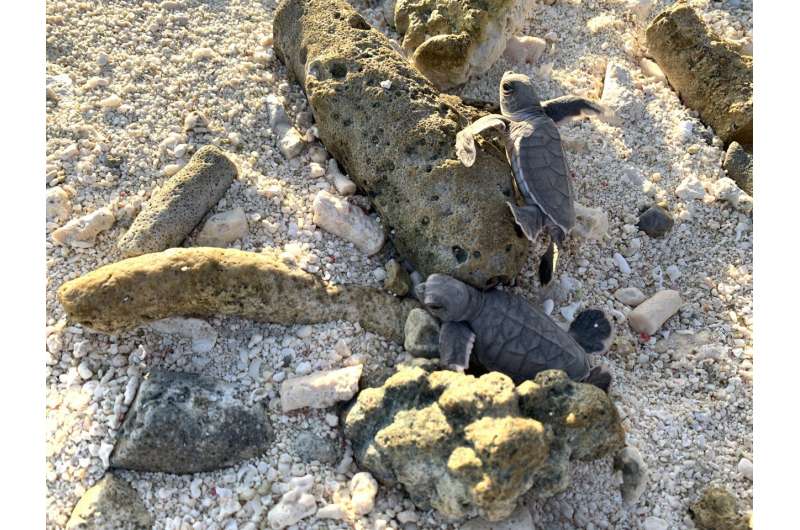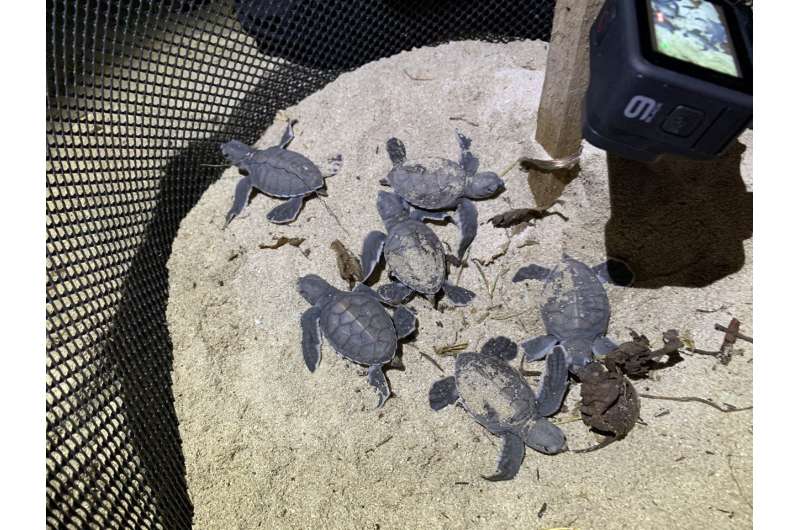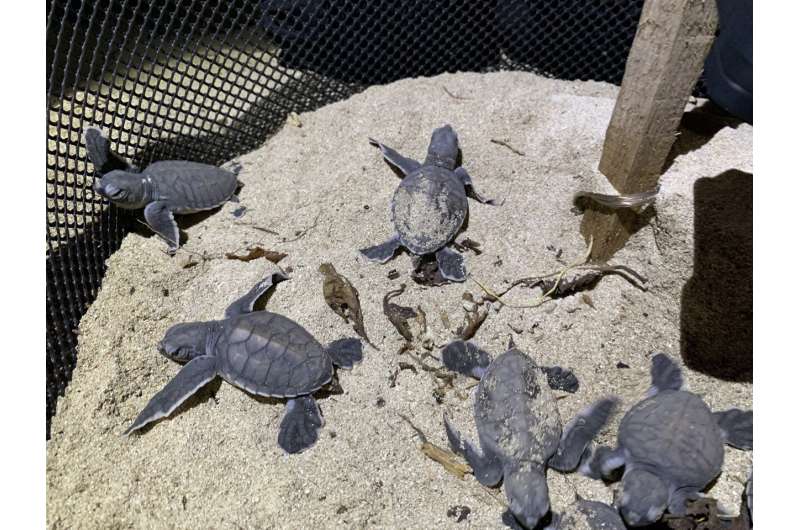This article has been reviewed according to Science X's editorial process and policies. Editors have highlighted the following attributes while ensuring the content's credibility:
fact-checked
peer-reviewed publication
trusted source
proofread
Endangered turtle population under threat as pollution may lead to excess female hatchlings

Green sea turtles, Chelonia mydas, are listed as endangered on the IUCN Red List of Threatened Species. They are at risk of extinction due to poaching, collisions with boats, habitat destruction, and accidental capture in fishing gear.
But another threat, linked to climate change, is more insidious: sea turtles have temperature-dependent sex determination, which means that more and more embryos develop into females as temperatures keep rising. Already, in the northern part of the Great Barrier Reef off Australia, hundreds of females are born for every male.
Now, researchers have shown that the resulting risk of extinction due to a lack of male green sea turtles may be compounded by pollution.
Dr. Arthur Barraza, a researcher at the Australian Rivers Institute at Griffith University and first author of a new study in Frontiers in Marine Science said, "Here we show that contaminants from human activities may also influence the sex ratio of developing green sea turtles, increasing the already extant bias towards females."
Barraza and colleagues studied the effects of pollution on the development of green sea turtles on Heron Island, a small coral sand cay in the southern Great Barrier Reef. This island, where between 200 and 1,800 females come to nest every year, is a long-term monitoring site for this species. Here, the sex ratio is currently more balanced than nearer the equator, with approximately two to three females hatching for every male.
Turtle Cooling Project
The present study was part of WWF-Australia's Turtle Cooling Project, which looks into ways to counter anthropogenic influences on turtle sex ratios. Every effort was made to minimize animal suffering and to maximize the amount of data obtained from each sacrificed turtle hatchling. The study had been approved by the animal ethics committee of the University of Queensland and the Queensland Parks and Wildlife Services.
The authors collected 17 entire clutches within two hours after the eggs were laid, and reburied them nearby adjacent to automatic temperature probes. These registered the temperature inside the nest and at the beach surface every hour.

When the hatchlings emerged, they were euthanized and their sex was determined by dissecting out and examining the sexual organs. Their livers was also removed and contaminants in it were measured, using inductively coupled plasma mass spectrometry (ICP-MS) as well as bioassays on cultured sea turtle cells.
Suspected estrogen mimics
Here, the authors focused on 18 metals such as chromium, antimony, and barium, as well as organic contaminants like polycyclic aromatic hydrocarbons (PAHs), polychlorinated biphenyls (PCBs), and polybrominated diphenyl ethers (PBDEs). In model organisms, these are all known or suspected to function as 'xenoestrogens': molecules that bind to the receptors for female sex hormones.
"Accumulation of these contaminants by a female turtle happens at the site where she forages. As eggs develop within her, they absorb the contaminants that she accumulated. These then are sequestered in the liver of the embryos, where they can stay for years after hatching," said Barraza.
The final sex ratio varied from 100% males to 100% females between clutches, although the majority of nests produced mainly female hatchlings. The greater the average amount of the heavy metals antimony and cadmium in the hatchlings' liver, the greater the bias towards females within the nest.

Contaminants cause broods to be feminized
The authors concluded that these contaminants mimic the function of the hormone estrogen, and tend to redirect developmental pathways towards females.
"As the sex ratio gets closer to 100% females, it will get harder and harder for adult female turtles to find a mate. This becomes especially important as climate change will continue to make nesting beaches warmer and more female-biased," said Barraza.
Senior author Dr. Jason van de Merwe, from the same institute, added, "Determining which specific compounds could change the hatchling sex ratios is important for developing strategies to prevent pollutants from further feminizing sea turtle populations.
"Since most heavy metals come from human activity such as mining, runoff, and pollution from general urban center waste, the best way forward is to used science-based long-term strategies to reduce the input of pollutants into our oceans."
More information: Arthur D. Barraza et al, Exploring contaminants as a disruptor of temperature-dependent sex determination in sea turtle hatchlings, Frontiers in Marine Science (2023). DOI: 10.3389/fmars.2023.1238837
Journal information: Frontiers in Marine Science
Provided by Frontiers




















